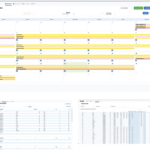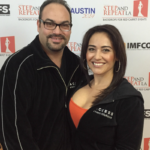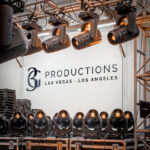Since forming video production company DWP Live in Oct. 2007, founder Danny Whetstone and his team have become widely known for projection-mapping — beaming static or moving designs onto a 3-D surface so that the images follow the topography of the surface, including window cornices, columns, doors — even gargoyles. One industry publication has gone so far as to call the company projection mapping’s “world heavyweight champion.”
 Before launching DWP Live, Whetstone had spent 12 years as a video engineer and director for artists as varied as Tool, Keith Urban, Bon Jovi, Red Hot Chili Peppers, Sting, Barry Manilow and Gwen Stefani, among many others. He used his down time for forays into corporate work on conferences, trade shows and automotive shows.
Before launching DWP Live, Whetstone had spent 12 years as a video engineer and director for artists as varied as Tool, Keith Urban, Bon Jovi, Red Hot Chili Peppers, Sting, Barry Manilow and Gwen Stefani, among many others. He used his down time for forays into corporate work on conferences, trade shows and automotive shows.
It was the Stefani concerts, where projection mapping gave the stage a different look for every song, that prompted the Middle Tennessee State University alumnus to fully consider the possibilities of the then-nascent technology. A light bulb went off, as they say. He decided to take the knowledge he had accumulated in the touring and corporate worlds and streamline it into a company that focused on doing one thing and doing it very well: video projection.
“Luckily, we had a customer already lined up,” he said, “which enabled us to get started and overcome the ‘new guy’ stigma. Since then, we have grown organically into a great company with steady business.” Despite launching on the cusp of the economy’s meltdown, the company has continued its success. “In 2008, we started buying our first hardware,” explains the DWP founder. “We started small, with six projectors and built from there. By owning our gear, we could control expenses for our customers, allowing us to get a foothold and build a base of clients. Companies that didn’t own their gear couldn’t control their pricing because they were at the mercy of rentals. And because we own the gear, it’s always on hand, so our people can train on it, learn it inside and out, and become experts at operating and maintaining it.”
 Super Bowl XLVI
Super Bowl XLVI
With 23 fulltime employees and drawing on local labor pools and trusted freelance technicians as needed, the company takes on about 40 projects a year. They have ranged from projection maps on targets as small as a running shoe for Saucony to as massive as the halftime show at the 2012 Super Bowl that starred Madonna, M.I.A., Cee Lo Green, Nicky Minaj and LMFAO.
Work on the football extravaganza in Indianapolis began with a phone call from production designer Bruce Rodgers in August 2011. “I had worked with Bruce’s people before, projection mapping for a Brazilian musician’s DVD shoot. For the halftime show, we spent a few months going through a number of different design iterations and budget considerations. After Bruce nailed down the final design he wanted to see, we laid out the pixel counts for how tall and wide the images were going to be on the 11,000-square-foot projection surface and matched the light levels so everything was balanced and would look good on camera. We went into Lucas Oil Stadium 27 days before the game and hung 32 Barco FLM HD-20 projectors in eight four-projector pods more than 150 feet above the field. That involved observing a lot of NFL rules for safety, since there would be football players underneath. Then we got to work matching the design pixel-by-pixel to what we would have on the field, did some rehearsals at offsite locations and only a few at the stadium itself (which was usually occupied the week before the big game with press events and team practices). We were ready for some football!”
The projectors were operated, converged and edge-blended using the Barco Projector Toolset located at the main control computer on Level 3 above the 50-yard line. The 12-minute program, done live before many millions of viewers around the world, involved miles and miles of cable, 796 11.25 mm lightweight FLED tiles built into 14 LED stage carts, dozens of dancers, the stars and 500 stagehands.
 Laser Scans, 3D Modeling
Laser Scans, 3D Modeling
For a recent projection onto a façade at Caesar’s Palace in Las Vegas, DWP had a laser scanning company first map every inch of the surface in extreme detail and create a 3D model of the building. The model was given to the content creators, who designed all of their content directly onto it. After computer refinements like stitching and warping (to match the curves, window frames and figurines on the structure), the final content was beamed onto the building in an exact fit as tight as a decal.
Along with its role as host of the Projection Mapping Boot Camp during the Event Marketing Summit in Chicago last May, DWP Live has supported tours by Dolly Parton and Hank Williams, Jr., along large, complex events for corporate clients like Mohawk Industries, Sherwin-Williams and Mercedes-Benz.
 The company, with fully equipped offices in Smyrna, Tenn. (near Nashville), and Los Angeles, also must be amassing a huge cache of frequent flyer credits. Assignments have taken them to Las Vegas several times (e.g., for Cinemacon three years running), Salt Lake City (USANA International Convention), New York City (World Humanitarian Day at the United Nations General Assembly Hall, with Beyoncé), Los Angeles (Electronic Entertainment Expo for Wargaming.net), San Francisco (Fusion-IO product launch), Oahu (Amway China’s annual awards gala at Pacific Aviation Museum), West Palm Beach, Fla. (Flagler Museum) and South Barrington, Ill. (Willow Creek Community Church Christmas Program). Beyond the U.S., DWP Live has supported events in Bogotá, Colombia (the National Bicentennial Celebration in Plaza de Bolivar), and upcoming projects will take them to Cologne, Germany, and Paris, France.
The company, with fully equipped offices in Smyrna, Tenn. (near Nashville), and Los Angeles, also must be amassing a huge cache of frequent flyer credits. Assignments have taken them to Las Vegas several times (e.g., for Cinemacon three years running), Salt Lake City (USANA International Convention), New York City (World Humanitarian Day at the United Nations General Assembly Hall, with Beyoncé), Los Angeles (Electronic Entertainment Expo for Wargaming.net), San Francisco (Fusion-IO product launch), Oahu (Amway China’s annual awards gala at Pacific Aviation Museum), West Palm Beach, Fla. (Flagler Museum) and South Barrington, Ill. (Willow Creek Community Church Christmas Program). Beyond the U.S., DWP Live has supported events in Bogotá, Colombia (the National Bicentennial Celebration in Plaza de Bolivar), and upcoming projects will take them to Cologne, Germany, and Paris, France.
 Though well versed in solving the technical and electrical issues that go with working in different countries and cultures, Whetstone has found that getting clear information can be daunting. He recalls taking a job in Vladivostok, Russia, to help a certain head of state named Vladimir Putin to celebrate the opening of a natural gas pipeline. The task was the projection mapping of the ceiling of a 90-foot dome.
Though well versed in solving the technical and electrical issues that go with working in different countries and cultures, Whetstone has found that getting clear information can be daunting. He recalls taking a job in Vladivostok, Russia, to help a certain head of state named Vladimir Putin to celebrate the opening of a natural gas pipeline. The task was the projection mapping of the ceiling of a 90-foot dome.
“Getting to Vladivostok is not easy in any way, either for people or equipment. When we got there, we found that the event was not going to be in the city but on an island off the coast. The only way to get there was on a ferry that ran on a very irregular schedule. But we succeeded so well that, after we left, Mr. Putin had us come back four days later to do it again. We never actually got to meet him, since whenever he and his ministers were around, the Americans were sequestered away. So I can’t verify if he had his shirt on, but I did get to see his shoes from under a door at one point.”
Fail-Safe Redundancy
For the big, one-time events, DWP Live uses its own crew to program and operate the content, graphics and cameras. Long-term installations, such as the Welcome Wall the company did at the Country Music Hall of Fame in Nashville, are set up to run on their own with someone there trained on basic operation. DWP Live can also monitor them remotely in case something needs to be restarted or reprogrammed. “All of our systems have redundancy built in,” Whetstone points out, “because you never know when something might fail. We do everything in our power to prevent that and design our systems with automatic backups. We very rarely have to go to them, but it’s important to have them there.”
For most projects, the company relies upon Barco projectors, coolux Pandora’s Box media controllers, Vista Systems Spyder X20s for live content options and Draper screens. Most content is created using the Cinema 4-D and Maya programs, with AfterEffects for the special effects.
Monitoring New Technologies
To keep up with changes in projection technology — with projectors shrinking in size as they grow in resolution and luminous output, and with software capabilities changing even faster — Whetstone and his team attend NAB, LDI and InfoComm. “Two people on our staff are assigned to constantly monitor new trends, get demos of new products to try out, and help companies with beta testing,” he adds. “We’re very close partners with Barco and coolux and other manufacturers, so we learn from them what’s coming down the pipeline. By the time technologies reach the marketplace, we’ve already become experts on them. We’re very active in research and we have a young, super smart team that keeps up on everything.”
For DWP Live, “good enough” is not good enough. Says Whetstone, “We are committed to service, we are committed to quality, we are committed to good customer relationships, and we are committed to delivering 100 percent on what we say we’re going to deliver. I think we’re distinguished by our workflow, the quality of what we deliver, our complete understanding of how to gather information for the objects or the screens or whatever we’re going to project onto, and for building templates for content creators to match so everything comes together in a really seamless, easy fashion.”
For project videos, go to www.dwplive.com


